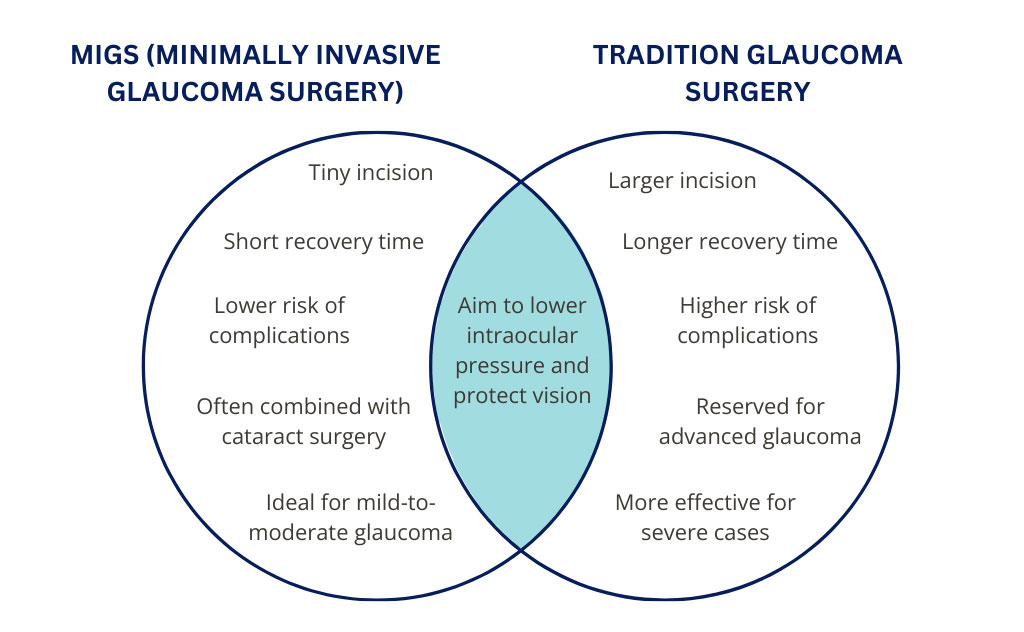Cost Comparison: Laser vs. Eye Drops vs. Surgery in the Philippines
Managing glaucoma is a long-term commitment that often requires a combination of treatments such as eye drops, laser therapy, or surgery. Each method differs not only in its medical approach but also in cost implications, which can significantly influence a patient’s decision.
In this guide, we will compare the costs of glaucoma treatments in the Philippines, outline the pros and cons of each option, and provide a detailed look at long-term affordability.
Eye Drops: Affordable Start, Expensive Long-Term
Eye drops are the most common initial treatment for glaucoma. They work by reducing intraocular pressure (IOP), either by decreasing fluid production or improving fluid drainage.
However, while eye drops have a low upfront cost, the long-term financial burden is often underestimated because glaucoma is a lifelong condition.
Average Cost in the Philippines
-
₱800 to ₱2,500 per bottle (depending on brand and formulation)
-
Each bottle usually lasts 3–4 weeks
-
Monthly Expense: ₱1,500–₱4,000
-
Annual Cost: ₱18,000–₱48,000
-
10-Year Cost: ₱180,000–₱480,000
Pros of Eye Drops:
-
Non-invasive and easy to use
-
Accessible in most pharmacies and hospitals
-
Immediate treatment option after diagnosis
Cons:
-
Lifetime cost is very high
-
Requires strict compliance (missing doses can worsen glaucoma)
-
Risk of side effects such as eye redness, stinging, or systemic effects
Laser Treatment: Cost-Effective Midpoint
Laser procedures, such as Selective Laser Trabeculoplasty (SLT) and Argon Laser Trabeculoplasty (ALT), offer an alternative for patients who want to reduce dependency on eye drops or who have compliance challenges.
Laser therapy uses targeted energy to improve fluid drainage in the eye, lowering IOP without incisions.
Cost of Laser Treatment in the Philippines
-
₱8,000 to ₱20,000 per session
-
Some patients may need repeat treatments after a few years
-
Typically performed on an outpatient basis
Advantages of Laser Therapy:
-
Reduces or eliminates the need for daily medications
-
Quick recovery with minimal discomfort
-
Lower risk compared to surgery
Disadvantages:
-
Effectiveness may diminish over time
-
Not all hospitals outside Metro Manila offer this service
-
May still require eye drops later
Find out the financial impact of glaucoma surgery in the Philippines
https://glaucoma.ph/glaucoma-treatment-cost-philippines-2025/
Glaucoma Surgery: High Initial Cost, Long-Term Value
When medications and laser fail, surgery is usually the next option. Common surgical choices include:
-
Trabeculectomy: Traditional procedure that creates a drainage flap
-
Tube Shunt Surgery: Involves implanting a drainage device
-
Minimally Invasive Glaucoma Surgery (MIGS): Less invasive, faster recovery
Cost of Glaucoma Surgery in the Philippines
-
Trabeculectomy: ₱40,000–₱90,000 per eye
-
Tube Shunt Surgery: ₱80,000–₱150,000 per eye
-
MIGS: ₱70,000–₱130,000 per eye
Pros:
-
Long-term IOP control
-
Reduced reliance on medications
-
Cost-effective over many years
Cons:
-
Higher upfront cost
-
Recovery period of several weeks
-
Risk of complications (though rare with skilled surgeons)
Cost Comparison Table
| Treatment Option | Initial Cost | Maintenance Cost | Long-Term Cost (10 yrs) |
|---|---|---|---|
| Eye Drops | ₱1,500–₱4,000/month | Lifetime recurring | ₱180,000–₱480,000 |
| Laser Therapy | ₱8,000–₱20,000 | Occasional repeat session | ₱16,000–₱40,000 |
| Surgery | ₱40,000–₱150,000 | Minimal aftercare | ₱40,000–₱150,000 |
5-Year Cost Scenario for Each Treatment
-
Eye Drops: ₱18,000/year → ₱90,000 (5 years)
-
Laser Treatment: ₱20,000/session × 2 sessions → ₱40,000
-
Trabeculectomy Surgery: One-time cost of ₱60,000–₱90,000
Clearly, while eye drops appear cheaper upfront, their cumulative cost over time can surpass surgery or laser treatment.
Availability in the Philippines
-
Eye drops: Widely available nationwide
-
Laser treatment: Offered in major hospitals and top eye centers in Metro Manila and select provinces
-
Surgery: Available in large hospitals, but advanced options like MIGS are mostly in urban centers
Does PhilHealth Cover Glaucoma Treatments?
-
Eye Drops: Not covered
-
Laser Therapy: May be partially covered under certain packages
-
Surgery: PhilHealth can shoulder part of the cost for trabeculectomy, reducing expenses significantly.
FAQs
1. Which is the cheapest glaucoma treatment in the long run?
Glaucoma surgery is the most cost-effective over a lifetime compared to drops or laser.
2. Are laser treatments available outside Metro Manila?
Mostly in major provincial hospitals, but availability is limited.
3. Can I combine treatments?
Yes, doctors often use a combination of drops, laser, and surgery for best results.
4. How soon can I work after surgery?
Light work is possible after 1–2 weeks; full recovery may take 4–6 weeks.
Key Takeaways
-
Eye drops are the easiest to start but most expensive long-term.
-
Laser treatment is cost-efficient and minimally invasive.
-
Surgery is expensive upfront but often the most economical over 10 years.
Discuss all options with your ophthalmologist, considering cost, availability, and effectiveness.
✅ Final Thoughts
Glaucoma management in the Philippines requires a balance between health outcomes and affordability. While eye drops remain the starting point, laser treatment and surgery offer better long-term value for patients committed to preserving vision and reducing lifetime costs.
Always consult a trusted eye care specialist for personalized advice before choosing a treatment path.




